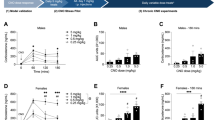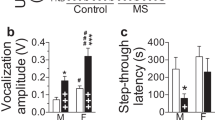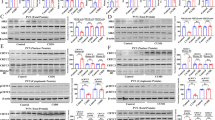Abstract
Hypersecretion of central corticotropin-releasing hormone (CRH) has been implicated in the pathophysiology of affective disorders. Both, basic and clinical studies suggested that disrupting CRH signaling through CRH type 1 receptors (CRH-R1) can ameliorate stress-related clinical conditions. To study the effects of CRH-R1 blockade upon CRH-elicited behavioral and neurochemical changes we created different mouse lines overexpressing CRH in distinct spatially restricted patterns. CRH overexpression in the entire central nervous system, but not when overexpressed in specific forebrain regions, resulted in stress-induced hypersecretion of stress hormones and increased active stress-coping behavior reflected by reduced immobility in the forced swim test and tail suspension test. These changes were related to acute effects of overexpressed CRH as they were normalized by CRH-R1 antagonist treatment and recapitulated the effect of stress-induced activation of the endogenous CRH system. Moreover, we identified enhanced noradrenergic activity as potential molecular mechanism underlying increased active stress-coping behavior observed in these animals. Thus, these transgenic mouse lines may serve as animal models for stress-elicited pathologies and treatments that target the central CRH system.
This is a preview of subscription content, access via your institution
Access options
Subscribe to this journal
Receive 12 print issues and online access
$259.00 per year
only $21.58 per issue
Buy this article
- Purchase on Springer Link
- Instant access to full article PDF
Prices may be subject to local taxes which are calculated during checkout






Similar content being viewed by others
References
Vale W, Spiess J, Rivier C, Rivier J . Characterization of a 41-residue ovine hypothalamic peptide that stimulates secretion of corticotropin and beta-endorphin. Science 1981; 213: 1394–1397.
Bale TL, Vale WW . CRF and CRF receptors: role in stress responsivity and other behaviors. Annu Rev Pharmacol Toxicol 2004; 44: 525–557.
Steckler T, Holsboer F . Corticotropin-releasing hormone receptor subtypes and emotion. Biol Psychiatry 1999; 46: 1480–1508.
Arborelius L, Owens MJ, Plotsky PM, Nemeroff CB . The role of corticotropin-releasing factor in depression and anxiety disorders. J Endocrinol 1999; 160: 1–12.
Nemeroff CB, Widerlov E, Bissette G, Walleus H, Karlsson I, Eklund K et al. Elevated concentrations of CSF corticotropin-releasing factor-like immunoreactivity in depressed patients. Science 1984; 226: 1342–1344.
Holsboer F . The rationale for corticotropin-releasing hormone receptor (CRH-R) antagonists to treat depression and anxiety. J Psychiatr Res 1999; 33: 181–214.
de Kloet ER, Joels M, Holsboer F . Stress and the brain: from adaptation to disease. Nat Rev Neurosci 2005; 6: 463–475.
Raadsheer FC, van Heerikhuize JJ, Lucassen PJ, Hoogendijk WJ, Tilders FJ, Swaab DF . Corticotropin-releasing hormone mRNA levels in the paraventricular nucleus of patients with Alzheimer's disease and depression. Am J Psychiatry 1995; 152: 1372–1376.
Zobel AW, Nickel T, Kunzel HE, Ackl N, Sonntag A, Ising M et al. Effects of the high-affinity corticotropin-releasing hormone receptor 1 antagonist R121919 in major depression: the first 20 patients treated. J Psychiatr Res 2000; 34: 171–181.
Nielsen DM . Corticotropin-releasing factor type-1 receptor antagonists: the next class of antidepressants? Life Sci 2006; 78: 909–919.
Hokfelt T, Johansson O, Ljungdahl A, Lundberg JM, Schultzberg M . Peptidergic neurones. Nature 1980; 284: 515–521.
Zorrilla EP, Valdez GR, Nozulak J, Koob GF, Markou A . Effects of antalarmin, a CRF type 1 receptor antagonist, on anxiety-like behavior and motor activation in the rat. Brain Res 2002; 952: 188–199.
Ising M, Zimmermann US, Kunzel HE, Uhr M, Foster AC, Learned-Coughlin SM et al. High-affinity CRF1 receptor antagonist NBI-34041: preclinical and clinical data suggest safety and efficacy in attenuating elevated stress response. Neuropsychopharmacology 2007; 32: 1941–1949.
Stenzel-Poore MP, Cameron VA, Vaughan J, Sawchenko PE, Vale W . Development of Cushing's syndrome in corticotropin-releasing factor transgenic mice. Endocrinology 1992; 130: 3378–3386.
Groenink L, Dirks A, Verdouw PM, Schipholt M, Veening JG, van der Gugten J et al. HPA axis dysregulation in mice overexpressing corticotropin releasing hormone. Biol Psychiatry 2002; 51: 875–881.
Zambrowicz BP, Imamoto A, Fiering S, Herzenberg LA, Kerr WG, Soriano P . Disruption of overlapping transcripts in the ROSA beta geo 26 gene trap strain leads to widespread expression of beta-galactosidase in mouse embryos and hematopoietic cells. Proc Natl Acad Sci USA 1997; 94: 3789–3794.
Tronche F, Kellendonk C, Kretz O, Gass P, Anlag K, Orban PC et al. Disruption of the glucocorticoid receptor gene in the nervous system results in reduced anxiety. Nat Genet 1999; 23: 99–103.
Minichiello L, Korte M, Wolfer D, Kuhn R, Unsicker K, Cestari V et al. Essential role for TrkB receptors in hippocampus-mediated learning. Neuron 1999; 24: 401–414.
Monory K, Massa F, Egertova M, Eder M, Blaudzun H, Westenbroek R et al. The endocannabinoid system controls key epileptogenic circuits in the hippocampus. Neuron 2006; 51: 455–466.
Soriano P . Generalized lacZ expression with the ROSA26 Cre reporter strain. Nat Genet 1999; 21: 70–71.
Friedrich G, Soriano P . Promoter traps in embryonic stem cells: a genetic screen to identify and mutate developmental genes in mice. Genes Dev 1991; 5: 1513–1523.
Mombaerts P, Wang F, Dulac C, Chao SK, Nemes A, Mendelsohn M et al. Visualizing an olfactory sensory map. Cell 1996; 87: 675–686.
Muller MB, Zimmermann S, Sillaber I, Hagemeyer TP, Deussing JM, Timpl P et al. Limbic corticotropin-releasing hormone receptor 1 mediates anxiety-related behavior and hormonal adaptation to stress. Nat Neurosci 2003; 6: 1100–1107.
Dagerlind A, Friberg K, Bean AJ, Hokfelt T . Sensitive mRNA detection using unfixed tissue: combined radioactive and non-radioactive in situ hybridization histochemistry. Histochemistry 1992; 98: 39–49.
Stalla GK, Stalla J, Schopohl J, von Werder K, Muller OA . Corticotropin-releasing factor in humans. I. CRF stimulation in normals and CRF radioimmunoassay. Horm Res 1986; 24: 229–245.
Timpl P, Spanagel R, Sillaber I, Kresse A, Reul JM, Stalla GK et al. Impaired stress response and reduced anxiety in mice lacking a functional corticotropin-releasing hormone receptor 1. Nat Genet 1998; 19: 162–166.
Radulovic J, Ruhmann A, Liepold T, Spiess J . Modulation of learning and anxiety by corticotropin-releasing factor (CRF) and stress: differential roles of CRF receptors 1 and 2. J Neurosci 1999; 19: 5016–5025.
Mayorga AJ, Dalvi A, Page ME, Zimov-Levinson S, Hen R, Lucki I . Antidepressant-like behavioral effects in 5-hydroxytryptamine(1A) and 5-hydroxytryptamine(1B) receptor mutant mice. J Pharmacol Exp Ther 2001; 298: 1101–1107.
Singewald N, Kaehler S, Hemeida R, Philippu A . Release of serotonin in the rat locus coeruleus: effects of cardiovascular, stressful and noxious stimuli. Eur J Neurosci 1997; 9: 556–562.
Graus-Porta D, Blaess S, Senften M, Littlewood-Evans A, Damsky C, Huang Z et al. Beta1-class integrins regulate the development of laminae and folia in the cerebral and cerebellar cortex. Neuron 2001; 31: 367–379.
Cummings S, Elde R, Ells J, Lindall A . Corticotropin-releasing factor immunoreactivity is widely distributed within the central nervous system of the rat: an immunohistochemical study. J Neurosci 1983; 3: 1355–1368.
Steru L, Chermat R, Thierry B, Simon P . The tail suspension test: a new method for screening antidepressants in mice. Psychopharmacology (Berl) 1985; 85: 367–370.
He L, Gilligan PJ, Zaczek R, Fitzgerald LW, McElroy J, Shen HS et al. 4-(1,3-Dimethoxyprop-2-ylamino)-2,7-dimethyl-8-(2,4-dichlorophenyl)pyrazolo[1,5-a]-1,3,5-triazine: a potent, orally bioavailable CRF(1) receptor antagonist. J Med Chem 2000; 43: 449–456.
Liebsch G, Landgraf R, Gerstberger R, Probst JC, Wotjak CT, Engelmann M et al. Chronic infusion of a CRH1 receptor antisense oligodeoxynucleotide into the central nucleus of the amygdala reduced anxiety-related behavior in socially defeated rats. Regul Pept 1995; 59: 229–239.
Sillaber I, Rammes G, Zimmermann S, Mahal B, Zieglgansberger W, Wurst W et al. Enhanced and delayed stress-induced alcohol drinking in mice lacking functional CRH1 receptors. Science 2002; 296: 931–933.
Cullinan WE, Herman JP, Battaglia DF, Akil H, Watson SJ . Pattern and time course of immediate early gene expression in rat brain following acute stress. Neuroscience 1995; 64: 477–505.
Bale TL, Vale WW . Increased depression-like behaviors in corticotropin-releasing factor receptor-2-deficient mice: sexually dichotomous responses. J Neurosci 2003; 23: 5295–5301.
Korosi A, Veening JG, Kozicz T, Henckens M, Dederen J, Groenink L et al. Distribution and expression of CRF receptor 1 and 2 mRNAs in the CRF over-expressing mouse brain. Brain Res 2006; 1072: 46–54.
Nishikawa H, Hata T, Itoh E, Funakami Y . A role for corticotropin-releasing factor in repeated cold stress-induced anxiety-like behavior during forced swimming and elevated plus-maze tests in mice. Biol Pharm Bull 2004; 27: 352–356.
Butler PD, Weiss JM, Stout JC, Nemeroff CB . Corticotropin-releasing factor produces fear-enhancing and behavioral activating effects following infusion into the locus coeruleus. J Neurosci 1990; 10: 176–183.
Garcia-Lecumberri C, Ambrosio E . Differential effect of low doses of intracerebroventricular corticotropin-releasing factor in forced swimming test. Pharmacol Biochem Behav 2000; 67: 519–525.
Tezval H, Jahn O, Todorovic C, Sasse A, Eckart K, Spiess J . Cortagine, a specific agonist of corticotropin-releasing factor receptor subtype 1, is anxiogenic and antidepressive in the mouse model. Proc Natl Acad Sci USA 2004; 101: 9468–9473.
van Gaalen MM, Stenzel-Poore MP, Holsboer F, Steckler T . Effects of transgenic overproduction of CRH on anxiety-like behaviour. Eur J Neurosci 2002; 15: 2007–2015.
Britton KT, Koob GF . Effects of corticotropin releasing factor, desipramine and haloperidol on a DRL schedule of reinforcement. Pharmacol Biochem Behav 1989; 32: 967–970.
Porsolt RD, Bertin A, Jalfre M . Behavioral despair in mice: a primary screening test for antidepressants. Arch Int Pharmacodyn Ther 1977; 229: 327–336.
Lucki I . The forced swimming test as a model for core and component behavioral effects of antidepressant drugs. Behav Pharmacol 1997; 8: 523–532.
Geyer MA, Markou A . Animal models of psychiatric disorders. In: Bloom F, Kupfer D (eds). Psychopharmacology: The Fourth Generation of Progress. Raven Press: New York, 1995, pp 787–798.
Chen Y, Bender RA, Brunson KL, Pomper JK, Grigoriadis DE, Wurst W et al. Modulation of dendritic differentiation by corticotropin-releasing factor in the developing hippocampus. Proc Natl Acad Sci USA 2004; 101: 15782–15787.
Chen Y, Brunson KL, Adelmann G, Bender RA, Frotscher M, Baram TZ . Hippocampal corticotropin releasing hormone: pre- and postsynaptic location and release by stress. Neuroscience 2004; 126: 533–540.
Staub DR, Evans AK, Lowry CA . Evidence supporting a role for corticotropin-releasing factor type 2 (CRF2) receptors in the regulation of subpopulations of serotonergic neurons. Brain Res 2006; 1070: 77–89.
Van Pett K, Viau V, Bittencourt JC, Chan RK, Li HY, Arias C et al. Distribution of mRNAs encoding CRF receptors in brain and pituitary of rat and mouse. J Comp Neurol 2000; 428: 191–212.
Bittencourt JC, Sawchenko PE . Do centrally administered neuropeptides access cognate receptors?: an analysis in the central corticotropin-releasing factor system. J Neurosci 2000; 20: 1142–1156.
Valentino RJ, Foote SL, Aston-Jones G . Corticotropin-releasing factor activates noradrenergic neurons of the locus coeruleus. Brain Res 1983; 270: 363–367.
Summers CH, Kampshoff JL, Ronan PJ, Lowry CA, Prestbo AA, Korzan WJ et al. Monoaminergic activity in subregions of raphe nuclei elicited by prior stress and the neuropeptide corticotropin-releasing factor. J Neuroendocrinol 2003; 15: 1122–1133.
Linthorst AC, Penalva RG, Flachskamm C, Holsboer F, Reul JM . Forced swim stress activates rat hippocampal serotonergic neurotransmission involving a corticotropin-releasing hormone receptor-dependent mechanism. Eur J Neurosci 2002; 16: 2441–2452.
Curtis AL, Lechner SM, Pavcovich LA, Valentino RJ . Activation of the locus coeruleus noradrenergic system by intracoerulear microinfusion of corticotropin-releasing factor: effects on discharge rate, cortical norepinephrine levels and cortical electroencephalographic activity. J Pharmacol Exp Ther 1997; 281: 163–172.
Smagin GN, Swiergiel AH, Dunn AJ . Corticotropin-releasing factor administered into the locus coeruleus, but not the parabrachial nucleus, stimulates norepinephrine release in the prefrontal cortex. Brain Res Bull 1995; 36: 71–76.
Koob GF . Corticotropin-releasing factor, norepinephrine, and stress. Biol Psychiatry 1999; 46: 1167–1180.
Alonso G, Szafarczyk A, Balmefrezol M, Assenmacher I . Immunocytochemical evidence for stimulatory control by the ventral noradrenergic bundle of parvocellular neurons of the paraventricular nucleus secreting corticotropin releasing hormone and vasopressin in rats. Brain Res 1986; 397: 297–307.
Acknowledgements
We thank Claudia Kühne, Katja Mayer, Tanja Orschmann, Daniela Kohl and Jessica Koepke for excellent technical assistance, Johanna Stalla for performing CRH RIAs, Ursula Habersetzer for endocrinological measurements, Maik Engeholm for vector construction and Peter Weber for his photographic expertise. We thank Ralf Kühn, Susanne Bourier and Sawoula Michailidou for blastocyst injection and generation of chimeric mice. We thank P Soriano and P Mombaerts for gifts of plasmids pROSA26-1 and ETLpA-/LTNL, respectively. D Refojo is supported by the European Molecular Biology Organization Fellowship Programme. This work was partially supported by the Bundesministerium für Bildung und Forschung within the framework of the NGFN2 (01GS0481) and by the Fonds der Chemischen Industrie.
Author information
Authors and Affiliations
Corresponding author
Additional information
Supplementary Information accompanies the paper on the Molecular Psychiatry website (http://www.nature.com/mp)
Supplementary information
Rights and permissions
About this article
Cite this article
Lu, A., Steiner, M., Whittle, N. et al. Conditional mouse mutants highlight mechanisms of corticotropin-releasing hormone effects on stress-coping behavior. Mol Psychiatry 13, 1028–1042 (2008). https://doi.org/10.1038/mp.2008.51
Received:
Revised:
Accepted:
Published:
Issue Date:
DOI: https://doi.org/10.1038/mp.2008.51



